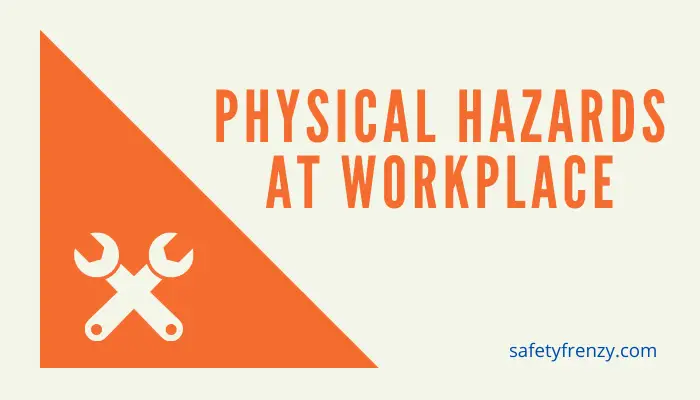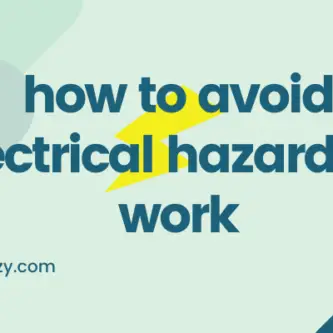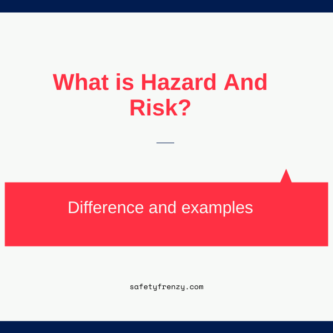What are Physical hazards at workplace?
Physical hazards at the workplace are types of hazards that can accidentally harm a worker.
In other words, we can define it as, Factors in a working environment that harm workers without necessarily touching.
In this article, we will discuss different types in detail. We will also discuss how to avoid these types of hazards in workplace.
why is physical hazard dangerous?
A physical hazard is dangerous because it can cause losses, pain, injuries, or death. It is also costly to the organization.
Let’s take one of the physical hazards, stress, as an example and see why is it dangerous.
Say we have a worker in a big organization who is working under stress, he is a driver of a bus.
The driver’s task is clear and easy, at the morning and afternoon he drives 25 workers from and to the working site. Easy and clear task! isn’t it?
Now, Jimmy, the driver is under stress, no matter what! If, one day while Jimmy is driving to the working site, just like every day for the last 15 years, he is involved in an accident!
If he, and the organization, of course, is lucky the bus wouldn’t crash and nobody will get hurt. Do you think the worker’s energy will be as normal this day? Probably no! Their output will be lower than on a normal day.
In the worst case, if Jimmy still working under stress, he may this time involve in a bigger accident! the bus would crash and the workers would get hurt and even die.
This short story happens. doesn’t it? We can see clearly how dangerous is a physical hazard.
If a physical hazard can cause losses in both lives and assets in a clear easy task, you can imagine what may happen if Jimmy, the driver, isn’t a driver of a bus, but a driver of heavy equipment like a crane, or even if he is an operator of a big machine, or is an electrician.
Yep, a physical hazard is dangerous and can lead to disasters bigger than we can imagine.
where does physical hazard come from?
Physical hazards come from a variety of sources depending on the type of hazard.
A physical hazard exists in almost all workplaces.
For example:
- Stress hazard comes from bad work management, personal issues, and bullying from careless coworkers.
- Electrical hazards almost exist at all workplaces even in offices. It comes basically from the need for electrical energy to run machines and devices. Electrical panels and power cables are the common shapes of electrical hazards.
- Noise physical hazard comes from machines and trucks, which are a must at factories, construction sites, and some other workplaces.
- Height hazard comes from tasks that require the worker to work at height, like repairing street lighting poles. We can’t fix it on the ground level.
- Temperature hazard comes from weather conditions that we can’t control or comes from a source at the workplace itself like iron and steel mills where furnaces produce high temperature all the time.
- Radiation hazard comes from radioactive sources that come out of underground oil and other sources. In my work, at an Oil company, radiation does exist in oil processing areas. Workers are subjected to it for long periods. Of course, they have working hours and limits to reduce the radiation on their bodies.
The point is, the source of physical hazards depends on the type of this hazard.
In many cases, the only thing we can do is to set control and measures to reduce this hazard. As I will share with you later in this article.
what is a physical hazard example?
We can classify physical hazards at the workplace as occupational or environmental hazards. And main examples include :
- stress
- noise
- radiation
- confined spaces
- electricity
- heights
- heat and cold (Temperature exposure), and more.
Let’s discuss each one in detail.
Machines
Machines are common sources of accidents in the workplace. Because machines have sharp edges, moving parts, hot surfaces, radiation, noise, electricity, and other hazards.
And mostly accidents like a crush, cut, burn, stab, etc. are caused due to this.
To minimize hazards, we suggest using proper safety tools like personal protective equipment (PPE).
And also check the machines for the auto-lock and auto-stop facilities in case of an emergency.
Electricity
Electricity is another source of fatality if we don’t deal with it properly.
Non-insulated electric wires can cause electric shock, and sometimes overloading can cause burns, fire, and even explosions in the workplace.
To overcome this electrical hazard proper safety tools like insulated gloves and safety shoes, and protection devices like circuit breakers must be used.
Proper training of employees and workers is necessary to ensure a safe work environment.
For more information about electrical safety read my articles:
Fire hazard
Fire is another big source of physical hazards in workplace. And every workplace has the risk of fire.
Workers, as well as employees, are equally prone to fire. The most common fire sources at work are kitchens and electrical short circuits.
To control fire it is important to install smoke detectors, and fire extinguishers in the workplace where there is a risk of oil or gas leakage.
A safety plan, Proper training, and an emergency exit have an important role in fire protection.
Read also our articles my articles:
Confined Spaces
First, what is a confined space? It is a place with limited entry and egress. These types of spaces are not suitable for human inhabitants.
Example of confined space is storage tanks, tunnels, Mines, etc. these places have a limited oxygen level.
And the chances of explosion and other physical hazards at the workplace are much more. Other accident types include flooding and collapsing.
Take into account that some workers may have a phobia of closed places. In this case, Never Ever Force such a person to work inside a confined place.
High Temperatures
Extreme temperatures are another source of physical hazards at the workplace. Extreme temperature includes both the highest and lowest level of temperature.
- If the temperature level is very low at the workplace. It can trench foot, and cause hypothermia, reduced dexterity, and mental alertness.
- While if the temperature level is too high at the workplace. It will cause dehydration and dizziness. and heatstroke in workers.
Both extremes are fatal and proper safety equipment must be used to overcome the situation.
If the workplace has flammable material, the extreme temperature increase may cause fire or explosions.
Another physical hazard at workplace are heights
Working at heights is another shape of physical hazard, It is a high-risk activity and it can cause fatality or serious injuries.
Using falling personal protective equipment is essential to end a key factor in protection against fall hazards.
For more information read our detailed articles: What is harness? and how to use it?
Working at heights is not belong to one working department. i.e all departments may involve in a job one day that requires working at heights.
In my workplace, many tasks require my team, electricians and electrical engineers, to work at heights facing this physical hazard. We use a bucket truck and safety harness for such tasks.
To prevent this hazard, all working at height PPE should be provided for all involved departments.
Also, make sure all workers are able to use these PPE, and most important you should ask if someone has a height phobia.
Noise at workplace
Noise can lead to permanent or temporary hearing loss.
If you need to raise your voice to be heard then the noise is excessive. If you are working in noisy places wear your ear PPE i.e ear plugs & hearing muffs.

Examples of noisy workplaces are :
- Electrical power generation plants.
- Water pumps plants.
- Factories that have loud machines.
- Construction sites where are many heavy trucks and cranes.
- Digging machines.
how to prevent physical hazards?
To prevent physical hazards at workplace follow the following safety tips:
- The first step to prevent physical hazards at a workplace is to identify all physical hazards surrounding your team while working. You can’t prevent what you don’t know about! can you?
- A good PPE program should be the second step. You should provide all suitable PPE for all tasks and workers.
- Make sure all workers are aware of these hazards around them. Not only the hazard relating to his task. When all workers are aware of all physical hazards at the workplace, they should help each other to prevent and avoid the hazard.
- All employees should stick to the PPE program. Wear all PPE equipment they require for a task, and make sure they use the PPE equipment the right way.
- If possible, prevent the source of the hazard. Make sure to decrease the noise levels, control the temperature of the machines and check electrical cables insulation, etc.
- A good training program, especially for new employees, should help very well and reduce the physical hazard at the workplace.
- Make sure to make social activities at the workplace, if possible, like having lunch together, from time to time. This is a good idea that can reduce stress and negative energy.
- Leaders should listen to the team members, talk to them and understand any possible stress they are facing.
- If a worker needs a vacation, if it’s OK, just send him on a vacation. If not possible, for any reason, never refuse without explaining to him why this is not the right time for a vacation, besides giving him time for getting a vacation.
Never Ever Refuse An Employee’s Vacation Without a Good Reason.
In my country, we heard about an employee who came up to the roof of the workplace building and committed suicide just because his boss put him under stress and refused to send him on a vacation.



